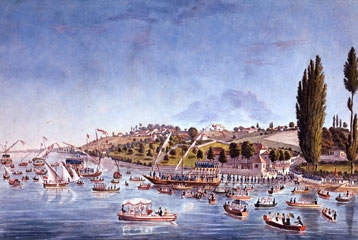On 19 May 1815, following a “French period” lasting more than fifteen years, Geneva joined the Confederation.
On 15 April 1798, one month after having occupied Berne, the troops of the French Directory (the executive power in France following the Revolution, from 1795 to 1799), supported by local Jacobins, invaded Geneva and annexed it to France. The city became the administrative town of a new département, called Léman. Subject to the protection of Napoleon Bonaparte from 1802, Geneva would remain in French hands until 1813.
The consequences of the French period
The repercussions of the annexation of Geneva by France were disastrous for the city’s economy, which endured a period of deep recession and stagnation: war and the Continental Blockade were the ruin of industrialists and bankers, who were the driving power behind the success of the city.
Nevertheless, the French regime also brought a number of new developments which would be retained after independence from France and membership of the Confederation, in particular the separation of the state and the church in a new civil code and an administration directed by a mayor, two deputies and a municipal council.
Joining the Swiss Confederation
Suffering economically from the annexation to the “Great Nation”, Geneva hoped to regain its independence. This was achieved on 31 December 1813 when the French troops were driven from the city by the Austrian army.
Having regained its independence, Geneva was acutely aware of the need to ally itself with a larger state. At that time, the period of the city state was over and isolation no longer appeared a viable option. Geneva therefore turned to the Swiss Confederation, with which it had long fostered close ties.
The city nevertheless had to satisfy two sine qua non conditions to be able to join the Confederation: to free itself from French territory and to present a constitution that would be reassuring to the other Confederates. The Catholic cantons were wary of the “Protestant Rome”. The Congresses of Vienna and Paris set the new borders of the canton. With the addition of twelve municipalities from Savoy and a further six from Gex, the territory of Geneva now touched that of Switzerland. The new constitution was drafted as quickly as possible by a council of seven members and voted by the people on 14 August 1814. On 19 May 1815, the canton of Geneva – a historic ally – joined the Confederation and became the 22nd Swiss canton.
Economic revival and modernisation
After joining the Swiss Confederation, the city’s economy slowly regained momentum with the return of the banking and watchmaking activities. The textile industry, however, never recovered from the economic recession and it would be 1830 before the economy of Geneva recovered completely.
Democratisation
Henceforth, the liberal bourgeois and educated workers constantly campaigned for the democratisation of the institutions. This was achieved in part with the Constitution of 1841 and the more completely with the Constitution of 1847, which established and elective democracy. It was also in 1847 that the Genevan politician, James Fazy, a businessman and radical politician, arrived on the political scene in Geneva. He would make a huge contribution to modernising the city.
Liens externes
Article modifié le 08.01.2024 à 12:40

